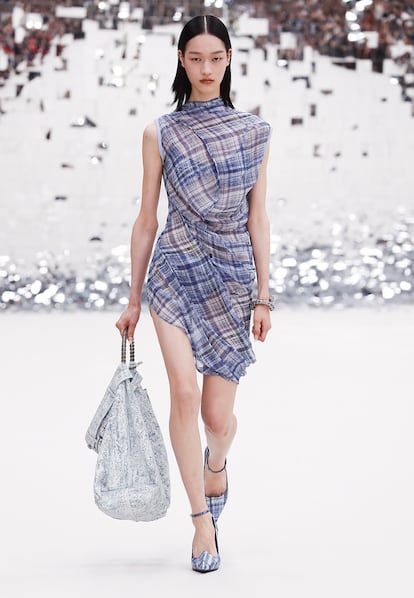Where are the curvy models that were going to save us from the culture of extreme thinness?
The latest fashion weeks made it clear that, for the big luxury houses, inclusivity is merely symbolic; it is the small, independent firms that are taking plus sizes seriously

Among the many topics that emerged during the recent fashion weeks, the lack of diversity was one of the most recurring. On one hand, the appointment of Seán McGirr as the new creative director of Alexander McQueen put the spotlight on the fact that all the main designers of the Kering conglomerate’s brands are white men. On the other, there is the idea that extreme thinness is back on the runway. We have gone from the trend of accentuating curves with procedures like the Brazilian Booty Lift to the normalization of slimming drugs, even among people who are not overweight. This season, examples like Miu Miu’s minuscule garments or the micro shorts that Sabato de Sarno created for his first collection at Gucci show us that the fashion industry is once again worshipping ultra-thin bodies. Did it ever stop, really?
For a while, it seemed like things had changed. In 2011, Vogue Italia dedicated one of its covers to plus-size models Tara Lynn, Candice Huffine and Robyn Lawley, and small steps were taken to increase the diversity of body types. Versace included plus models on the runway for the first time in 2021, brands like Dolce & Gabbana started to offer more sizes and initiatives and campaigns promised representation at all levels. However, it all seems to have been strategically superficial.
“This past spring, we saw a drop [in size diversity], which had to do with the return of the thin beauty ideal and the acceptance of the Y2K aesthetic,” says Lauren Downing Peters, academic, professor of fashion studies and author of Fashion Before Plus-Size. “In general, this change is due to a couple of reasons. First, there is the cyclical nature of beauty ideals. While the canon of thinness first emerged around 1900, each decade a more or less curvy type has been favored in response to different sociopolitical forces. The shift away from the curvy ideal of the past decade is, at least in part, a result of the pendulum swinging in the other direction, but it is also the result of a post-Covid 19 backlash and the popularity of weight loss drugs like Ozempic. The other reason is that brands realized that producing their clothes in an inclusive range of sizes is not only expensive but also complicated. Many brands that tried, recently abandoned their initiatives.”
As Downing Peters points out, independent brands like Karoline Vitto are the ones that currently show greater inclusivity, both in sizes and body types. On the other hand, the production of luxury houses — despite their resources and high budgets — usually does not reach higher than sizes 12 or 14. Including a plus-size model in the presentations of these brands is basically a symbolic gesture. An example is that the Miu Miu pleated micro skirt that Paloma Elsesser wore for an editorial in i-D magazine had to be made to measure, as the company did not actually made it in the model’s size. High fashion, by not implementing any real initiative, would be turning their backs on a large percentage of consumers, in addition to giving up a global plus-size market that — as Future Markets estimates — could move approximately $288 billion.
According to the fashion search engine Tagwalk, 36% of all spring/summer 2024 shows included at least one plus-size person. This represents an increase of +46% compared to fall/winter 2023 and +32% compared to spring/summer 2023. Geographically speaking, London is the most inclusive city, with 59% of presentations featuring at least one plus-size person, while Milan and Paris would vie for the bottom of that list.

Model Felicity Hayward has been personally tracking the presence of curvy models for two years in her own report called #IncludingTheCurve. In the most recent fashion month (September-October 2023), among more than 13,000 models that walked, 228 were plus-size models, with most coming from independent designers like Collina Strada, Chopova Lowena, Sinéad O’Dwyer, Christian Siriano and Karoline Vitto (who only used size-inclusive models in her show). On the other hand, according to data from Tagwalk, the LVMH Group brands did not include any plus-size models, and only two Kering brands did so (Alexander McQueen and Balenciaga). Other big names like Chanel, Dolce & Gabbana, Michael Kors and Versace did include plus models in their shows. If we look at the numbers, the fashion weeks did see an improvement compared to previous seasons, but there is still a long way to go.
Beyond the world of haute couture, there are affordable brands that do offer a wide variety of sizes, such as Universal Standard, Reformation, Mango or online retailers like ASOS. In social media, Pinterest stands out; the platform now uses artificial intelligence to increase the presence of different body types. The company claims that thanks to this technology representation has quintupled in fashion-related searches in the U.S. Something revealing is that on Pinterest there is no room for negative comments or trolling. The big names must lead the way to end diet culture and the effects it has on our well-being and our mental health; but in other areas, such as social networks, we can all do our part.
Sign up for our weekly newsletter to get more English-language news coverage from EL PAÍS USA Edition
Tu suscripción se está usando en otro dispositivo
¿Quieres añadir otro usuario a tu suscripción?
Si continúas leyendo en este dispositivo, no se podrá leer en el otro.
FlechaTu suscripción se está usando en otro dispositivo y solo puedes acceder a EL PAÍS desde un dispositivo a la vez.
Si quieres compartir tu cuenta, cambia tu suscripción a la modalidad Premium, así podrás añadir otro usuario. Cada uno accederá con su propia cuenta de email, lo que os permitirá personalizar vuestra experiencia en EL PAÍS.
¿Tienes una suscripción de empresa? Accede aquí para contratar más cuentas.
En el caso de no saber quién está usando tu cuenta, te recomendamos cambiar tu contraseña aquí.
Si decides continuar compartiendo tu cuenta, este mensaje se mostrará en tu dispositivo y en el de la otra persona que está usando tu cuenta de forma indefinida, afectando a tu experiencia de lectura. Puedes consultar aquí los términos y condiciones de la suscripción digital.
More information
Archived In
Últimas noticias
Rowan Atkinson tops Netflix at 70: ‘He’s as funny as ever’
Israeli recognition of Somaliland stirs up the Gulf
Tiger Woods turns 50: Will he continue playing on the PGA Tour or take a back seat?
The surreal journey of James Nnaji, the Barcelona youth player selected in the NBA Draft who ended up in the NCAA
Most viewed
- Oona Chaplin: ‘I told James Cameron that I was living in a treehouse and starting a permaculture project with a friend’
- Reinhard Genzel, Nobel laureate in physics: ‘One-minute videos will never give you the truth’
- Sinaloa Cartel war is taking its toll on Los Chapitos
- Why the price of coffee has skyrocketed: from Brazilian plantations to specialty coffee houses
- Chevy Chase, the beloved comedian who was a monster off camera: ‘Not everyone hated him, just the people who’ve worked with him’










































